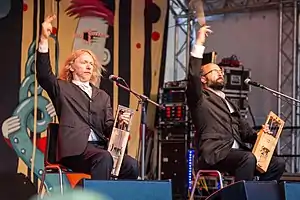Talharpa
The talharpa, also known as a tagelharpa (tail-hair harp) or the stråkharpa (bowed harp), is a four-stringed bowed lyre from northern Europe. It was formerly widespread in Scandinavia, but is today played mainly in Estonia, particularly among that nation's Swedish community. It is similar to the Finnish jouhikko and the Welsh crwth. The instrument is still known in Finland.[1]

The name talharpa probably comes from tagel - horsehair - from which the strings were made.[2]

Background
The earliest known Norse literary mentions of a harp or lyre date to the Eddic poem Völuspá, though not as a bowed instrument. However, visual representations from iconography show Gunnar charming the snakes in the snake pit with a harpa and a stone carving at the Trondheim Cathedral of Norway shows a musician playing a bowed lyre. In Nordic countries the bowed lyre (as opposed to the plucked harp) has continued in Finland where it is called jouhikantele and Estonia where it is called the talharpa.[3]
Modern use
The talharpa is sometimes used in modern folk music. Most notably by the Estonian nu-folk duo Puuluup[4] who use talharpas and modern live looping

See also
- Crwth
- Jouhikko
- Gue
- Byzantine lyra (bowed lyre)
- Hiiu kannel (in Estonian)
- Bowed string instrument
References
- Montagu, Jeremy (2007). Origins and Development of Musical Instruments. Scarecrow. p. 174.
- Andersson, Otto (1930). The Bowed Harp. Translated and edited by Kathleen Schlesinger. London: New Temple Press p. 111
- Rice, Timothy (2017). The Garland Encyclopedia of World Music: Europe. Routledge. p. 730. ISBN 1351544268. Retrieved 13 August 2019.
- , Puuluup official website
External links
 Media related to Hiiukannel at Wikimedia Commons
Media related to Hiiukannel at Wikimedia Commons- "Einar Selvik of the band Wardruna demonstrates playing the tagelharpa".